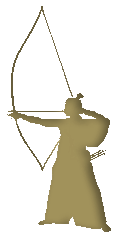
Martial math III-The margin of zero*
Explaining Aikido! Ha... That would be something!
Explaining Aikido is like trying to mislead someone into the opposite direction of understanding it... And now that I think about it, the opposite way, is actually a good place to start...
So, let’s rephrase: Why Aikido cannot be explained! Okay... That sentence makes more sense to me, and one stays closer to the truth as well...
If we take Einstein’s famous equation (E=mc2) the first thing one might notice, is that it is actually very short. If then, we are told by someone what it is all about and what it means, it is possible to be understood without taking… brain damage!
Okay so far, but now let us look behind the simplicity of that we see first, let us think backwards... Let us see the person behind this equation, let us see the depth of his knowledge, let us see the immense size of the work in order to put this together.
Last but not least, apart from a superficial explanation, this tiny equation is a total deception on its part for what it really is…
The answer to a problem, equation or understanding, is one thing. And it usually appears simple, plain and crystal clear... and in many ways, it is! But the road which precedes an answer, any answer, is an entirely different story.
Aikido is an Art in constant evolution for the last 900 years.
It is a construction of many Masters, some of them famous and some of them we will never know...
The techniques passed on to us, were actually used on the battlefield, were honed in personal duels, and were practiced in countless Dojos in times of peace… which has always been the natural training place of the Art, for both the Samurai and the modern “Peace Warrior”
Maybe the best way in order to understand how Aikido works, is to approach it in a backwards manner. This is done by beginning to practice, enjoying it and letting the understanding part for a bit later. Then, when some basic techniques have been put behind and some knowhow has been achieved, one can look back to his very own experience (even if it is little) and figure out how things work.
Now that I think about it, there is an even better way than this... It is to understand how Aikido works backwards and upside-down, all at the same time. This is a joke of course... but not entirely!
Once entering a Dojo one might be (or become) “the right stuff” for a Sensei. If so, he will find himself serving as Uke. This position demands that most, if not all, techniques will be demonstrated on him...
Which in plain words means that this youngling will be orbiting the Dojo’s interiors like a satellite, spending more time in the air, in some pain and a lot of confusion about which direction is where... Hence, the term “upside-down”.
I had that marvelous position for a bit more than half a decade, and I can make a lot of jokes about it nowadays, but this kind of approach is as serious as things can get...
In order to learn, both understandings are necessary...
Don’t go away, I have more!
It is mostly after that, when the mind perceives better and deeper, what Aiki principles are all about, and how they do combine themselves with techniques, into one solid body called Aikido.
What we admire to see, and is performed with ability by those who have mastered the Art, goes first through that narrow path of understanding backwards and living upside-down...
And as I am fond of saying: There is no other way, because this is the way!
The margin between attack and defense
Aikido practice is done in a unique way…
On one hand, you don’t collide with your opponent while executing a technique, trying to subdue him. And on the other, you neither give way to an opening, which could be described as prearranged practice.
Between those two attitudes one must maintain a margin, and through that margin, effectively and efficiently control any attack.
All Aikido technique and mastery, is born in that margin.
If you squeeze it too tight, it dies… If you open it too wide open, it scatters…
Sadly, one can spend decades of practice, either strangling his own techniques or letting them escape.
Side by side to Aiki Principles and Aiki Techniques, the correct approach to practice and the correct attitude and mentality, is key to Aikido mastery…
In controlling an attack one must neither overextend himself, neither fall behind. He must gradually close his margin from being a gap to a thin line...
Masters, can make that line invisible, they can make it look as if it is not there, but it is.
This could be very well described as the study of zero.
Zero is not nothing and it is not something either.
And this is the very Epitome of Aikido...
It is not wise to assume or to interpret what a Samurai by the name of Tsukahara Bokuden did mean with his axiom, so many centuries ago. But for me, this is one of the best phrases among phrases, describing the Aiki-Principle for what it is.*“My art is different from yours
It consists not so much in defeating others
but in not being defeated”
Tsukahara Bokuden (1489 -1571)December 21, 2015